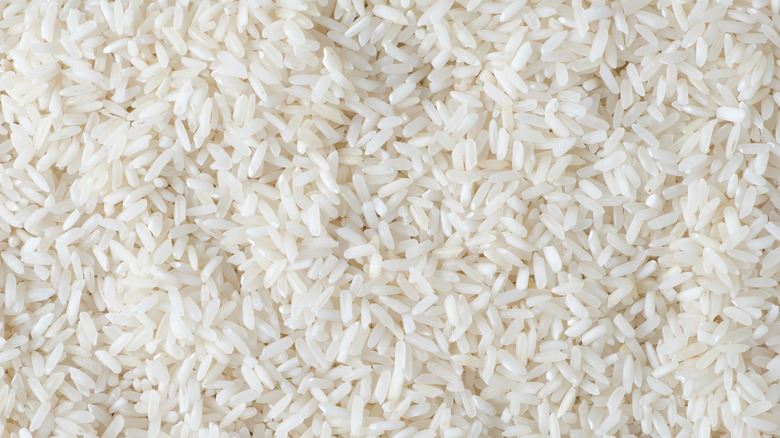The Essential Tip You Need For Perfectly Fluffy Rice Every Time
If you've been living under a rock and don't cook or go out to eat very often, you might be under the (mistaken) impression that the sole reason to keep a box or bag of rice in the cupboard is to use it to pull moisture from your smartphone should you somehow manage to submerge it in water. Here's a news flash: Rice is so much more than that. It literally is life in many parts of the world, and it's delicious, nutritious, and satisfying (per The Rice Association).
Somebody once said that rice is great if you're really hungry and want to eat 2,000 of something. He or she was no doubt referring to the grains in a serving of rice, but there are literally thousands of different kinds of rice – 40,000 types of cultivated rice, to be exact, according to The Rice Association. Rice is grown everywhere in the world except Antarctica.
Despite the vast variety, all rice comes from the same two types — japonica and indica. Think of them as the parents. Indica dominates the rice world and is known for having long, thin, delicate grains. The most common indica varieties are basmati and jasmine rice, the aromatic, snowy white grains we associate with Indian and South Asian cuisine (per the U.S. Department of Agriculture). While we might disagree on which variety is best, we probably can agree that rice is at its best when it's fluffy and hot.
Grab a fork and fluff your rice
Just as there are many different kinds of rice, it seems like there are just as many ways to cook rice: On the stove, in the oven, in an electric rice cooker, in a slow cooker, in an Instant Pot, in your handy-dandy microwave. You can even cook rice as you would pasta, draining off the starchy cooking water (per MyRecipes via YouTube). As simple as rice is on the surface, things can go awry when you cook it. You can overcook it (and have a mess of a pot or device to clean up). You can undercook it — and who wants crunchy rice with their shrimp and snow peas? Rice can also come out mushy and gummy (and really, the only time you want rice that gloms together is when you're making sushi or eating sticky rice).
Once you've arrived at a cooking method that works for you, the tip for having perfectly fluffy rice hit your plate (or bowl) every time is in your silverware drawer. You're going to need a fork (or some chopsticks) to eat the rice, but first, you're going to want to grab a fork and use it to fluff up the rice in whatever device you used to cook it. "Use a fork to gently mix and lift rice to make sure that the grains don't stick together,” advises Delish.
Does rice need to be rinsed?
A good place to start with rice is by following the instructions on the bag or box. Then, if the rice doesn't come out the way you want, try some experiments. Does rice need to be rinsed before cooking? Martha Stewart weighed in on this topic. Taking the time either to rinse rice under cold water (or submerge the rice in water and drain it) is worth the extra step because it eliminates the starch on the surface of the grains that causes them to bond together as they cook.
Another rice conundrum for some folks is arriving at the right ratio of water to rice. The prevailing wisdom is two parts water to one part rice, but the Food Network contends the secret to tender, perfectly cooked long-grain rice is one-and-a-half parts water to one part rice. If you're using basmati rice, soak it in cold water for 30 minutes first, as the recipe suggests. Another trick: Remove the rice from the heat after 18 minutes of simmer time and give it a 10-minute rest before — you guessed it — fluffing the rice with a fork.


